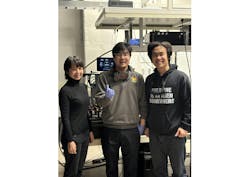By pulsing circularly polarized light—twisted like a helix—through an optical cavity lined with an ultrathin semiconductor, a team of University of Michigan researchers created an ultrafast all-optical switch.
An all-optical switch is essentially a building block of any information processing unit, and the team’s advance opens the door to all-optical computing, optical neural networks, and potentially quantum communications.
“Our work is inspired by the ways photonics can be used to control how light and electronic medium interact,” says Hui Deng, a professor of physics and electrical and computer engineering. “The electronic medium is complex, and we have limited ways to get information from it. For example, logic gates operate by adjusting conductivity and voltage—both are scalar quantities related to the density of electrons and how well they flow within the chip.”
But we understand light much better and there are many ways to control it. “Light can flow with little resistance and loss to carry information in different properties—such as intensity, polarization, and phase,” Deng says. “We can write-in, process, and read-out information with light by making it interact with an electronic medium. Our experience using cavities to control light-material interactions led us to this project.”
How do you create an all-optical switch?
The team crafts its cavity out of a pair of mirrors and a subnanometer-thick layer of tungsten diselenide (WSe2) to create an optical switch. Pulsing a helical laser through the cavity at regular intervals increases the laser strength by two orders of magnitude.
“The basic mechanism of switching is the optical Stark effect, in which the oscillating electric field of a control laser beam modifies the transition energy of electronic excitation within the material. This influences the passage of another light: the signal beam,” explains says Lingxiao Zhou, a physics Ph.D. student.
While the optical Stark effect is well established, it typically requires an intense laser. “The energy shift is still less than the transition linewidth, so it’s not feasible as a switch,” Zhou adds.
To address this, the team designed an asymmetric cavity to enhance the control laser, which allows the optical Stark effect to occur 100x more efficiently. “We can use a 100x-weaker control laser and demonstrate a shift 5x the linewidth,” explains Zhou. “We also use a nonlinear material, monolayer WSe2, which interacts very strongly with light through its exciton resonance. The electron spin of transition is locked to the momentum valley of the electron, which gives the transition inherent helicity.”
And using light of different helicities acts as a chirality switch—it enables low-power, ultrafast chirality optical switching.
In other words: Turning a control laser on or off switches the signal beam of the same polarization, which generates an output signal when one light input twists clockwise at the same time a second one twists counterclockwise.
A big challenge for applications will be to “integrate the device on-chip with high overall efficiency,” Deng points out.
The power of light fields
One of the coolest discoveries involved was when the team achieved the equivalent of a 200 Tesla magnetic field for splitting the energy levels of electronic spins by simply using light fields (for perspective, Earth’s strongest magnet has a strength of 100 Tesla). “It was a huge ‘a-ha!’ moment because it showed how much control we could have over material properties through light alone—because optical linearity is usually quite limited,” Zhou says.
The team didn’t know beforehand whether other effects or artifacts would set in and overwhelm the basic mechanism they relied on, so they were unsure how well the effect would work out. “Seeing it happen was absolutely thrilling—and it’s the kind of result that opens up entirely new ways of thinking about using light to manipulate both light and materials,” Zhou adds.
Cavity-enhanced Floquet engineering
The team’s work is an important advance because it demonstrates the potential of cavity-enhanced Floquet engineering to significantly improve the efficiency and speed of integrated optical communication systems.
Using a laser tuned far below the electronic transition energy—so the optical Stark effect is fully coherent—enables it to operate with minimal excitations or energy conversion. “This allows the switch to operate without loss and as fast as the laser pulse itself. It’s distinct from most current all-optical switches,” says Deng.
One problem with fully coherent switches is the requirement of high-intensity lasers, and the team’s work demonstrates cavity enhancement can provide a solution. “Looking ahead, cavity Floquet engineering has great potential to advance energy-efficient, high-speed optical control,” Deng says.
Quantum comms ahead?
The team’s current technology holds potential for high-speed communication systems, particularly applications in which light polarization serves as an additional communication dimension.
“The possibilities for high-dimensional optical communications are exciting,” says Deng. “While we’re still in the experimental phase, practical applications could begin to emerge within the next decade.”
Looking ahead, Zhou is excited to explore whether they can approach the quantum regime of Floquet engineering by using only a few photons to produce a measurable effect.
“Given the flexibility we have to manipulate the control laser, there’s also great potential to expand beyond light intensity and polarization to explore additional degrees of freedom of light, such as orbital angular momentum and topological properties,” Zhou says. “We’re eager to see how these advancements can be applied to quantum and complex communications systems—there’s so much potential waiting to be unlocked.”
FURTHER READING
L. Zhou et al., Nat. Commun., 15, 7782 (2024); https://doi.org/10.1038/s41467-024-52014-0.
About the Author
Sally Cole Johnson
Editor in Chief
Sally Cole Johnson, Laser Focus World’s editor in chief, is a science and technology journalist who specializes in physics and semiconductors.



